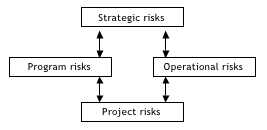Risk and interdependency in programs
By tying all schedules to a common resource pool, the overall utilisation and achievability of the program can be determined. Such an assessment may then lead to the need to prioritise or supplement resources.
Actual effort tracking in scheduling tools still remains complex and tedious, rarely worth the scheduling effort. Resourced schedules can however assist in the estimate to complete, and hence financial reporting, when combined with timesheet data. Resource models need to align to both the schedule as well as the timesheet and cost control systems, another area of complexity.
Issues, risk and change
On first glance, managing program issues, risk and change would appear to be similar to the approach used when managing a project. The program must consistently use common control tools, assessment criteria and metrics for tracking issues and risks similar to those used on a project. The subtlety comes in the overall context, especially the assessment of impact.
The following diagram shows the interrelationship between program, project, operational and strategic risks.
While a delay may appear to be high impact to the project manager, to the business as a whole the delay may not be such a large problem. Conversely a relatively small delay, in the project manager’s opinion, may have a significant effect on the business.
The program manager must have the strategic view, especially judging impact based on the business benefits the program needs to deliver. Program risk management will be more affected by organisational risk procedures and risk tolerance than individual projects, most likely with the involvement of corporate risk and audit people.
The key to program risk management is to centralise but separate the project and program risks. An escalation process will need to exist so that a project level risk can be escalated to the program level. Program level risk response plans need to be able to be allocated back to the projects and tracked accordingly. Any common project risks need to be able to be summarised and represented at the program level.
Issue management would also appear similar. The difference comes in the volume of issues, and because of the immediate nature of dealing with them, the need to prioritise. Issues and change are often closely aligned since change of scope or plans are often part of the response plan for an issue. Change must be managed from a program rather than project perspective, with a focus on impact to benefits delivery.
Risk and contingency budgets
When considering risk within a program, one often misunderstood area is the level of contingency and how that contingency should be shown. Program managers may distribute the financial contingency reserves or centralise them across the program. When centralised, the process for requesting and distributing needs to be carefully thought through. The representation of schedule contingency is also complex, once again standards and a defined process will help.
Options for contingency may include one or more of:
- Holding contingency outside program manager’s control, usually controlled by the sponsor.
- Creating a centralised risk or contingency budget, estimated based on the risk response plan costs and allowance for impact of unknowns, controlled by the program manager but perhaps authorised by the steering committee.
- Creating within each project a risk or contingency budget, controlled by the project manager but perhaps authorised by the program manager.
- Burying a level of contingency within detailed plans.
Management culture will impact the treatment of risk and contingency budgets, particularly where the contingency is mistakenly perceived as ‘fat’ rather than factored in the budget that will be used. Program managers will often need to educate senior management and the steering committee on managing risk and contingency budgets.
Developing an open and honest culture, where risks and issues can be raised without fear, is important. Program managers provide the leadership role to the project management team and are the link to senior management and business strategy. Success of a program is more often than not aligned to achieving the benefits, benefits to outcomes, outcomes to deliverables, deliverables to projects.
Projects are managed by project managers who are part of the program manager’s team. The team exists to deliver the program, not a series of disconnected deliverables. Teamwork includes working together in a consistent way, following a standard approach.
So managing a program is not the same as managing a project, it needs a different approach and a great deal of experience. The best approach is to learn from others, a great starting point is to read the UK’s Office of Government Commerce Managing Successful Programmes guide.


